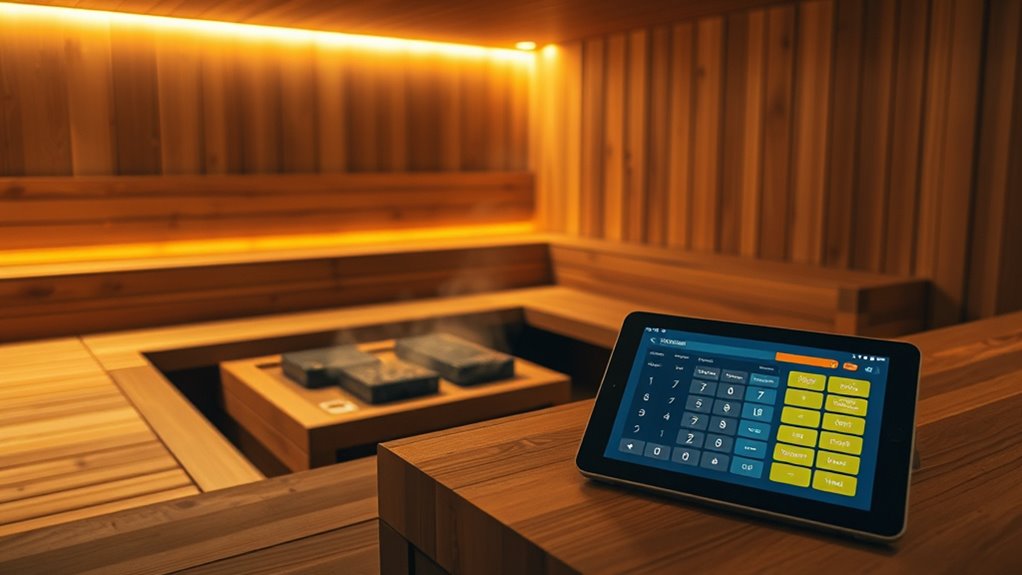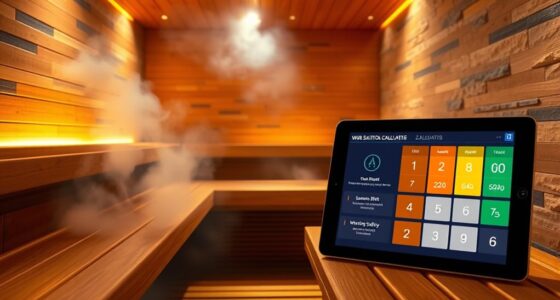Using a sauna before or after your workout depends on your goals, but many myths suggest timing drastically affects results. In reality, benefits like muscle recovery and relaxation occur regardless of when you use the sauna; what matters more is how you incorporate it safely. Temperature, duration, and hydration are key factors. If you’re curious about how to optimize your sauna sessions for your routine, there’s more to discover that can help you make smarter choices.
Key Takeaways
- Sauna timing (before or after workouts) offers similar recovery benefits; it does not significantly boost performance regardless of when used.
- Using a sauna post-exercise helps relax muscles and reduce soreness, aiding faster recovery.
- Pre-workout sauna sessions may influence performance due to potential fatigue or dehydration risks.
- Proper hydration and session duration are crucial, irrespective of sauna timing, to ensure safety and maximize benefits.
- Personal goals and comfort should guide sauna scheduling, as individual responses vary and myths about timing are largely unfounded.
Understanding the Benefits of Sauna Use in Fitness Routines

Understanding the benefits of sauna use in fitness routines can enhance your overall performance and recovery. Regular sessions help improve circulation, which delivers oxygen and nutrients to muscles more efficiently. To maximize these benefits, you should develop effective hydration strategies before, during, and after sauna use, preventing dehydration and supporting muscle function. Proper sauna maintenance is also essential; ensuring the sauna is clean and well-maintained helps prevent skin irritations and promotes a safe environment. Using the sauna after workouts can aid in muscle relaxation and reduce soreness, while pre-workout sessions can warm your muscles and improve flexibility. Additionally, monitoring air quality indicators and performing regular maintenance and cleaning of your sauna can help ensure it operates safely and efficiently. By integrating proper hydration and maintaining your sauna, you optimize its positive effects on your fitness journey, boosting recovery and performance.
Common Myths About Sauna Timing Before and After Workouts

Many people believe that using a sauna before workouts boosts performance, but this isn’t backed by science. Others think you should only sauna after exercising for relaxation, which isn’t necessarily true. The timing of your sauna session doesn’t substantially change its benefits, so you can enjoy it whenever it fits your routine. Additionally, understanding the impact of natural language processing can help tailor your wellness experience through personalized recommendations and feedback.
Sauna Boosts Performance Myth
A common myth suggests that spending time in a sauna either before or after a workout can considerably boost athletic performance. However, this isn’t supported by scientific evidence. While sauna aesthetics create a relaxing environment, they don’t directly enhance your physical capabilities. Rushing into a sauna with poor sauna etiquette, such as ignoring hydration or overexposing yourself, can actually hinder your recovery rather than improve performance. The idea that a quick sauna session will make you a stronger athlete is misleading. Instead, sauna use is best for relaxation and recovery. Relying on it as a performance booster ignores the importance of proper training, nutrition, and rest. Remember, the key to actual performance gains lies outside the sauna, not solely in your sauna timing. Additionally, understanding the role of temperature and humidity in sauna use can help you maximize its benefits without risking dehydration or overheating.
Post-Workout Relaxation Fallacy
While it’s tempting to unwind in a sauna immediately after your workout, this common belief that it promotes ideal recovery is a myth. Many think post workout relaxation in a sauna speeds healing, but research doesn’t fully support this. Sauna myths suggest it’s the best way to recover, yet overdoing it can cause dehydration or fatigue. Instead, focus on proper hydration and gentle stretching first. Using the sauna right after exercise isn’t always necessary and might not optimize benefits. Additionally, understanding AI safety protocols can help ensure that health-related technologies are used responsibly and effectively.
Timing Doesn’t Affect Benefits
Contrary to popular belief, the timing of your sauna session—whether before or after a workout—doesn’t substantially impact its benefits. Your focus should be on enjoying the experience rather than stressing over sauna aesthetics or sauna fashion. Whether you prefer to relax in the heat before hitting the gym or unwind afterward, the key benefits like muscle relaxation, improved circulation, and stress relief remain consistent. The idea that sauna timing affects results is a common myth; what truly matters is regularity and how you incorporate it into your routine. So, don’t get caught up in the details. Instead, choose what feels best for you and makes your sauna experience enjoyable and sustainable. Embracing modern slang and internet culture can also make your wellness journey more engaging and connected to youth trends.
How Sauna Sessions Can Impact Muscle Recovery and Performance

Sauna sessions can considerably boost muscle recovery and enhance performance by increasing blood flow and promoting the removal of metabolic waste. The heat induces muscle relaxation, reducing tightness and soreness after intense workouts. The circulatory benefits of sauna use help deliver oxygen and nutrients more efficiently to your muscles, speeding up recovery. Improved blood circulation also helps clear out lactic acid and other byproducts that cause fatigue. As your muscles relax, you’ll experience less stiffness and a quicker return to peak performance. Regular sauna sessions can support your training schedule by minimizing downtime and enhancing overall muscle health. Additionally, incorporating mindfulness techniques during sauna use can further reduce stress and promote mental clarity, benefiting overall well-being. Just remember, consistency and proper hydration are key to maximizing these benefits and ensuring your muscles recover preferably.
Factors to Consider When Deciding Sauna Timing Based on Your Goals

Your goals profoundly influence whether you should use the sauna before or after workouts. If your focus is on enhancing mental wellness, a post-workout session might help relax your mind and reduce stress. Conversely, if you’re aiming to boost performance or endurance, pre-workout sauna use could improve circulation and flexibility. Consider your hydration strategies; sauna sessions can lead to fluid loss, so plan to hydrate adequately before and after. For those seeking recovery, timing sauna use to align with rest periods maximizes benefits and minimizes fatigue. Be mindful of your emotional distance and how it might impact your routine, as maintaining a balanced approach can help prevent burnout. Always assess how sauna sessions fit into your overall routine and adjust based on your personal objectives. By tailoring your approach, you can optimize the mental and physical benefits of sauna use without risking dehydration or overexertion.
The Role of Sauna Temperature and Duration in Your Routine
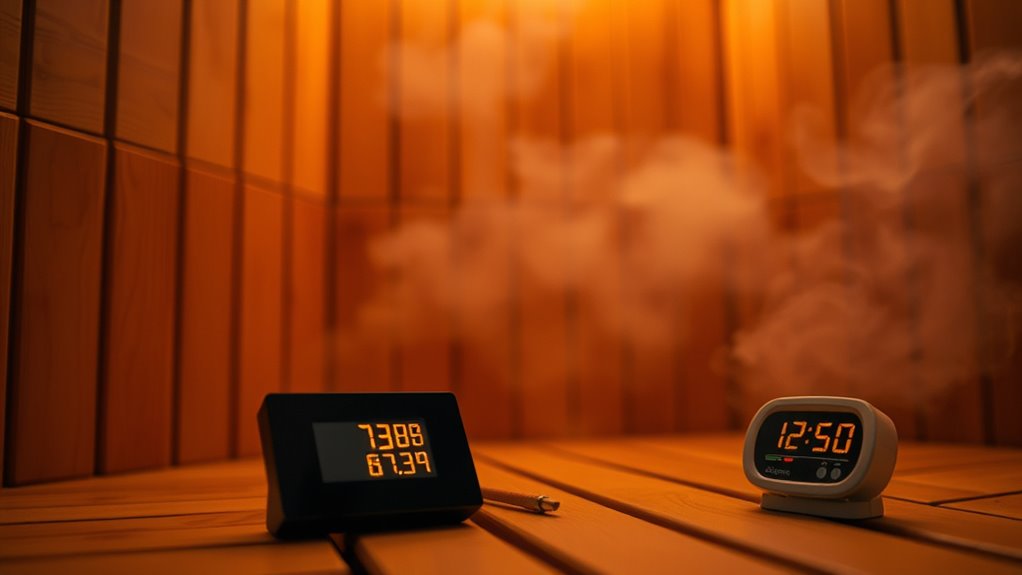
The temperature and duration of your sauna sessions substantially impact their benefits and safety. Staying within the ideal temperature range and keeping sessions to a sensible length can enhance relaxation and recovery. Too much heat or prolonged exposure, however, may lead to discomfort or health risks. Proper emergency preparedness can help you respond effectively in case of unexpected health issues during your sauna routine.
Optimal Temperature Range
Maintaining the right temperature during your sauna session is essential for maximizing benefits while ensuring safety. An ideal temperature range typically falls between 150°F to 175°F (65°C to 80°C). Staying within this range helps you achieve effective temperature regulation without overwhelming your heat tolerance. If the sauna is too hot, you risk dehydration or heat exhaustion; too cool, and you might not experience the full benefits. Listening to your body is key—gradually increasing the temperature helps build heat tolerance over time. Remember, the goal is to find a balance that allows you to sweat comfortably and safely, promoting relaxation and recovery without pushing beyond your limits. Proper temperature control is crucial for avoiding common risks associated with sauna use.
Ideal Sauna Duration
Choosing the right sauna duration is crucial for maximizing benefits and ensuring safety, especially when considering the temperature. Typically, 15 to 20 minutes is ideal, but listen to your body and adjust accordingly. Staying hydrated is essential, so incorporate effective hydration strategies before and after your session to prevent dehydration. The sauna ambiance can influence your comfort, so set an environment that promotes relaxation without pushing you beyond safe limits. Longer sessions may increase detoxification, but overdoing it can lead to dizziness or dehydration. Always pay attention to how you feel during your time inside—if you experience discomfort, leave the sauna immediately. Striking the right balance between duration and temperature helps you enjoy the benefits without risking your well-being. Additionally, selecting a cozy, inviting environment can enhance your overall experience and promote relaxation.
Effects of Heat Intensity
Heat intensity plays a significant role in shaping your sauna experience, influencing both your comfort and the benefits you receive. Higher temperatures can promote muscle flexibility, helping you relax tight muscles, but excessive heat may cause discomfort or dehydration. Ideal heat levels support cardiovascular health by increasing circulation without overtaxing your body. Duration also matters; prolonged exposure at intense heat can strain your system, while shorter sessions optimize benefits safely. Use the table below to gauge effective heat levels:
| Temperature Range | Recommended Duration | Focus Areas |
|---|---|---|
| 70–80°C (158–176°F) | 10–15 minutes | Muscle flexibility |
| 80–90°C (176–194°F) | 10 minutes | Cardiovascular health |
| 90–100°C (194–212°F) | 5–10 minutes | Intense detox or therapy |
| Above 100°C | Not recommended | Risk of overheating |
Adjust heat intensity based on your goals and comfort for safe, effective results.
Personalized Sauna Timing: Using the Calculator to Optimize Your Results
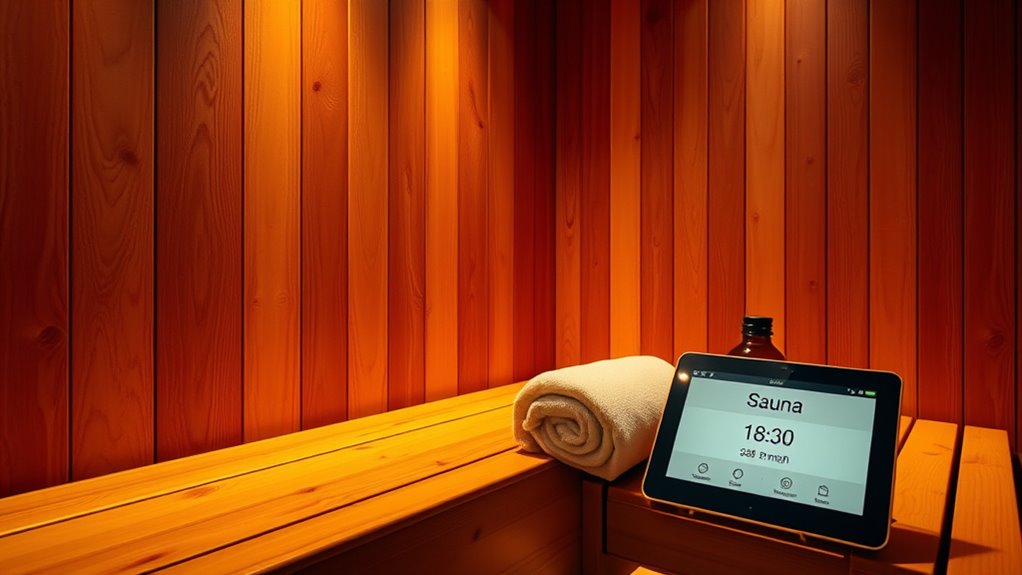
To get the most benefits from your sauna sessions, tailoring the timing to your workout schedule is essential. Use the calculator to determine when sauna use aligns best with your exercise, whether before or after. It helps you optimize recovery, performance, and relaxation. Incorporate hydration strategies by drinking water before and after your session to prevent dehydration, especially if you plan to sauna post-workout. The calculator can also suggest ideal durations and temperatures based on your goals. Additionally, consider sauna accessories like towels or cooling gels to enhance comfort and recovery. By personalizing your sauna timing, you maximize benefits while minimizing risks, ensuring your routine supports your fitness progress effectively.
Risks and Precautions When Incorporating Sauna Into Your Workout Schedule
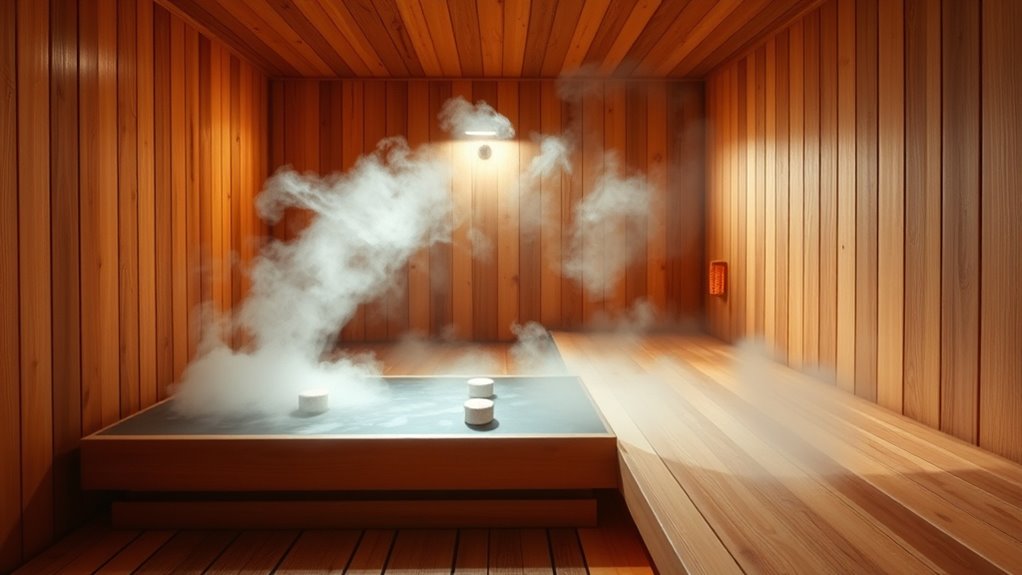
While incorporating sauna sessions into your workout routine can offer benefits, it’s important to be aware of potential risks. Dehydration is a major concern, so adopting proper hydration strategies is essential—drink plenty of water before and after sauna use. Overexposure to heat can also lead to dizziness, fainting, or heat exhaustion, especially if you have underlying health conditions. Additionally, sauna use may impact sleep quality if you go late at night, disrupting your recovery. To minimize risks, listen to your body, avoid prolonged sessions, and consult a healthcare professional if you have cardiovascular issues. Prioritizing hydration and being mindful of how sauna sessions influence your sleep can help you safely enjoy the benefits without adverse effects.
Practical Tips for Integrating Sauna Sessions Safely and Effectively

Incorporating sauna sessions into your workout routine requires mindful planning to maximize benefits and minimize risks. To do this effectively, consider these practical tips:
- Hydrate thoroughly before and after each session to support your nutritional impact and prevent dehydration.
- Limit session duration—20 minutes is usually enough—so you protect your mental health and avoid overheating.
- Schedule sauna use post-workout or during rest days, ensuring your body recovers properly without compromising performance.
- Monitor how you feel—if you experience dizziness or fatigue, adjust your frequency or intensity to safeguard mental well-being and optimize recovery.
Following these tips helps you enjoy the mental health benefits of sauna while supporting your overall fitness goals.
Interpreting Your Results: Making Informed Decisions for Your Fitness Journey

Understanding your results is vital for making informed decisions about your fitness journey. When reviewing how sauna sessions impact your progress, consider your hydration strategies; proper hydration helps optimize recovery and performance. Pay attention to how your body responds—if you notice excessive fatigue or dehydration, adjust your sauna frequency or duration. Additionally, maintaining your equipment is fundamental; clean and inspect sauna and workout gear regularly to guarantee safety and effectiveness. Interpreting your results means recognizing patterns and understanding what they reveal about your overall health. Don’t rely solely on one metric—combine feedback from hydration levels, comfort, and performance. Making these informed choices empowers you to optimize your routines, prevent setbacks, and stay aligned with your fitness goals.
Frequently Asked Questions
Can Sauna Use Replace Traditional Post-Workout Stretching or Recovery Methods?
Sauna use can’t replace traditional recovery techniques or stretching routines after workouts. While it helps relax muscles and improve circulation, it doesn’t address flexibility, reduce soreness, or restore muscle length like stretching does. Incorporate saunas as a complementary recovery method, but always prioritize proper stretching routines and other proven recovery techniques to guarantee ideal muscle health and performance.
How Does Sauna Use Affect Hydration Levels During Workouts?
Sauna use during workouts can significantly impact your hydration levels by increasing sweat loss, which may lead to dehydration if you don’t rehydrate properly. While sweating helps cool your body, it also drains fluids, making it essential to drink water before, during, and after sessions. Ignoring this can impair performance and recovery, so always balance sauna sessions with adequate hydration to prevent negative effects on your workout and overall health.
Are There Specific Sauna Types More Beneficial for Athletes?
You’ll find that infrared saunas, with their unique sauna material and design, are particularly beneficial for athletes. Infrared panels penetrate deeper into your muscles, aiding recovery and relaxation. Traditional wood saunas offer a different experience, promoting sweating and detoxification. Choosing a sauna material like cedar or spruce, combined with thoughtful sauna design, guarantees comfort and efficiency. Ultimately, pick a sauna type that aligns with your goals—infrared or traditional—for maximum benefits.
How Often Should I Incorporate Sauna Sessions Into My Fitness Routine?
Like a well-tuned instrument, your sauna routine needs careful timing. Generally, using the sauna 2-3 times a week fits well into most fitness plans, but it depends on your goals and recovery needs. Consider your body’s responses and adjust frequency considerations accordingly. For ideal scheduling, listen to how you feel afterward and avoid overdoing it, ensuring your sauna sessions enhance your performance and recovery without causing fatigue.
What Are the Signs That I Should Avoid Sauna Sessions Temporarily?
You should avoid sauna sessions if you notice signs of dehydration, like dry mouth, dizziness, or dark urine, or signs of overheating, such as excessive sweating, headache, or nausea. If your skin feels extremely hot or you’re feeling weak or dizzy, it’s best to skip the sauna. Listening to your body is key—if anything feels off, take a break and rehydrate before resuming your routine.
Conclusion
By understanding the facts and myths about sauna timing, you can make smarter choices—like tuning a musical instrument—to enhance your fitness journey. Remember, finding the right balance is like walking a tightrope; it requires awareness and care. Use the calculator to tailor your sauna sessions to your goals, and always listen to your body. With the right approach, your workouts and recovery can harmonize perfectly, leading to better results and a healthier you.
